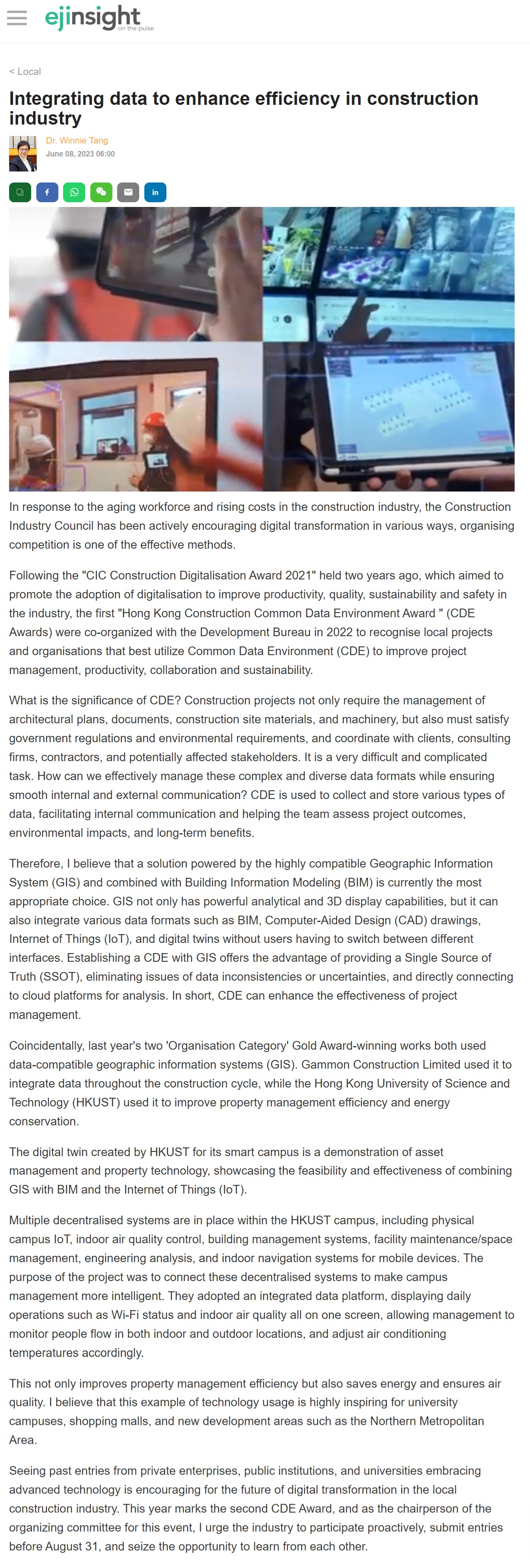網上版請按此

Integrating data to enhance efficiency in construction industry
In response to the aging workforce and rising costs in the construction industry, the Construction Industry Council has been actively encouraging digital transformation in various ways, organising competition is one of the effective methods.
Following the "CIC Construction Digitalisation Award 2021" held two years ago, which aimed to promote the adoption of digitalisation to improve productivity, quality, sustainability and safety in the industry, the first "Hong Kong Construction Common Data Environment Award " (CDE Awards) were co-organized with the Development Bureau in 2022 to recognise local projects and organisations that best utilize Common Data Environment (CDE) to improve project management, productivity, collaboration and sustainability.
What is the significance of CDE? Construction projects not only require the management of architectural plans, documents, construction site materials, and machinery, but also must satisfy government regulations and environmental requirements, and coordinate with clients, consulting firms, contractors, and potentially affected stakeholders. It is a very difficult and complicated task. How can we effectively manage these complex and diverse data formats while ensuring smooth internal and external communication? CDE is used to collect and store various types of data, facilitating internal communication and helping the team assess project outcomes, environmental impacts, and long-term benefits.
Therefore, I believe that a solution powered by the highly compatible Geographic Information System (GIS) and combined with Building Information Modeling (BIM) is currently the most appropriate choice. GIS not only has powerful analytical and 3D display capabilities, but it can also integrate various data formats such as BIM, Computer-Aided Design (CAD) drawings, Internet of Things (IoT), and digital twins without users having to switch between different interfaces. Establishing a CDE with GIS offers the advantage of providing a Single Source of Truth (SSOT), eliminating issues of data inconsistencies or uncertainties, and directly connecting to cloud platforms for analysis. In short, CDE can enhance the effectiveness of project management.
Coincidentally, last year's two 'Organisation Category' Gold Award-winning works both used data-compatible geographic information systems (GIS). Gammon Construction Limited used it to integrate data throughout the construction cycle, while the Hong Kong University of Science and Technology (HKUST) used it to improve property management efficiency and energy conservation.
The digital twin created by HKUST for its smart campus is a demonstration of asset management and property technology, showcasing the feasibility and effectiveness of combining GIS with BIM and the Internet of Things (IoT).
Multiple decentralised systems are in place within the HKUST campus, including physical campus IoT, indoor air quality control, building management systems, facility maintenance/space management, engineering analysis, and indoor navigation systems for mobile devices. The purpose of the project was to connect these decentralised systems to make campus management more intelligent. They adopted an integrated data platform, displaying daily operations such as Wi-Fi status and indoor air quality all on one screen, allowing management to monitor people flow in both indoor and outdoor locations, and adjust air conditioning temperatures accordingly.
This not only improves property management efficiency but also saves energy and ensures air quality. I believe that this example of technology usage is highly inspiring for university campuses, shopping malls, and new development areas such as the Northern Metropolitan Area.
Seeing past entries from private enterprises, public institutions, and universities embracing advanced technology is encouraging for the future of digital transformation in the local construction industry. This year marks the second CDE Award, and as the chairperson of the organizing committee for this event, I urge the industry to participate proactively, submit entries before August 31, and seize the opportunity to learn from each other.
Dr. Winnie Tang
Adjunct Professor, Department of Computer Science, Faculty of Engineering; Department of Geography, Faculty of Social Sciences; and Faculty of Architecture, The University of Hong Kong